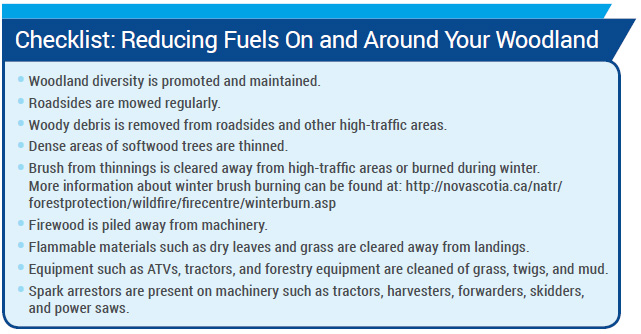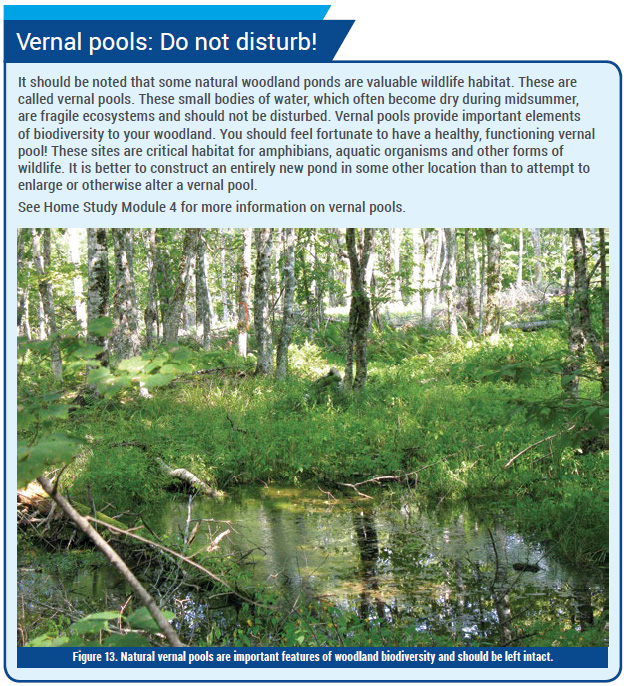Lesson 3 - Wildfire Prevention on your Woodland: Critical Steps
Decreasing the risk of wildfire should be a primary consideration for every woodland owner. Adopting a mindset in which you are responsible for the defence of your property is often the first step in constructing a strategy for reducing the risk of wildfire. By using a proactive approach, wildfire is preventable and—should a fire escape—damage to your property can be minimized. As we learned in Lesson 1, you can initiate wildfire prevention by removing potential fuel sources and making sure that fire has fewer opportunities to develop into a wildfire.
Reduce Your Fuel Load
There are many steps you can take to reduce the availability of fuels and make sure your property is protected from wildfire. If you have a camp, trailer, or other dwelling on your woodland, you should be even more cautious in your approach to fie prevention. Following is a checklist you can use to make sure you have taken the necessary steps to prevent wildfire:
|
|
Construct Woodland Ponds
One of the most significant structures a woodland owner can construct to control fires is a fie pond in an accessible location. Fire ponds provide the peace of mind that year-round water is available if it is needed to suppress a local fie. If there is already a natural pond in an accessible location on your woodland, make sure that it is large enough to hold plenty of water year-round. Be sure it is not a vernal pool, since these small areas contribute immensely to the biodiversity of your woodland.
|
|
Woodland fie ponds are not difficult o construct. The best time to choose a location for a pond is when you are building a woodland road, since the excavated soil can be used in road construction. Small sites with year-round supplies of fresh water located next to a road are good choices for ponds.
You may be surprised how quickly a woodland fie pond assumes a character of its own. After construction, the margins of the pond soon teem with plants and insects, while amphibians begin to inhabit the shallows where there is abundant food.
Figure 14. A woodland pond can be a valuable source of water Like any body of water, a fie pond can be potentially hazardous to forest workers and the public. It is your responsibility as the landowner to make sure that your pond is safe for everyone. The pond should be clearly marked with signage to indicate that deep water is present, particularly if it is adjacent to an access road.
|
|
Ponds as Habitat
Any small bodies of water in woodlands are natural habitats for wildlife, including wetland plants. Constructed ponds may replicate vernal pools, which are some of the most valuable wildlife habitat in woodland areas. Here, freshwater aquatic organisms live in close proximity to terrestrial animals and birds. Salamanders, newts, frogs, and other amphibians are important inhabitants of pools and ponds. They feed on small invertebrates and in turn provide food for animals and birds further up the woodland food chain. Raccoons, mink, red fox, and other mammals may stop by to check on the resources your pond has offered them. If you are really fortunate, your pond may support a small colony of fish lie sticklebacks, mudpuppies, or brook trout, adding another dimension to the health and wealth of your woodland.
For further details on conserving and enhancing woodland habitat, see Home Study Module 4 (Woodlots and Wildlife).
|
|
By reducing the fuel load and making sure that an ample supply of water is available if it is needed, you have taken the critical first steps in peventing wildfie on your woodland. By constructing or maintaining a fie pond, you will have also contributed to the wildlife habitat on your property—and added a significant component o the biodiversity of your woodland!



